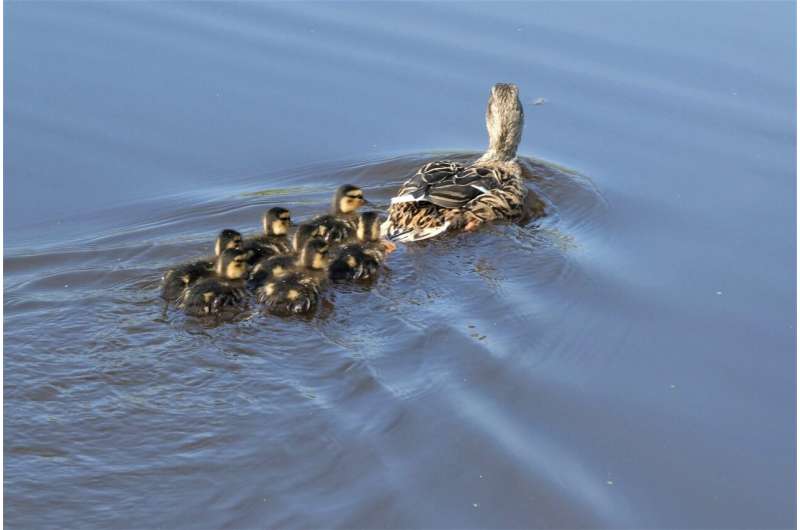Riding the waves keeps ducks in a row

The sight of ducklings paddling in a line behind their mother is a common sight in rivers and ponds across the country.
But just why do they swim in that formation? Scientists at the University of Strathclyde believe they have discovered the reason—which could have applications in maritime shipping too.
In a research paper published in the Journal of Fluid Mechanics, naval architecture experts conclude that ducklings benefit from ‘wave riding’ and ‘wave passing.”
Using a mathematical and numerical model, the researchers found that when a duckling swims at a ‘sweet point’ behind its mother a ‘destructive wave interference phenomenon’ occurs. This causes the wave drag of the duckling to turn positive meaning the baby bird is actually pushed forward by the wave.
Interestingly this wave-riding benefit appears to be passed down to the rest of the ducklings in the line formation.
Dynamic equilibrium
Starting from the third duckling the wave drag of individuals gradually tends towards zero, and a delicate dynamic equilibrium is achieved. Each individual under that equilibrium acts as a wave passer, passing the waves’ energy to its trailing companion without any energy losses.
Dr. Zhiming Yuan, senior lecturer in the Department of Naval Architecture, Ocean & Marine Engineering, who led the study, said: “Wave riding and wave passing are probably the principal reasons for the evolution of swimming formation by waterfowl.
“This study is the first to reveal the reasons why the formation movement of waterfowl can preserve individuals’ energy expenditure. Our calculations provide new insights into the mechanisms of formation swimming.
These principles could be potentially applied to design modern freight carrying vessels, e.g. a water-train, to transport more cargoes without extra fuel cost.
The results of the study were obtained used the ARCHIE-WeST High Performance Computer based at the University of Strathclyde.
Mathematical tools predict if wave-energy devices stay afloat in the ocean
Zhi-Ming Yuan et al, Wave-riding and wave-passing by ducklings in formation swimming, Journal of Fluid Mechanics (2021). DOI: 10.1017/jfm.2021.820
Citation:
Riding the waves keeps ducks in a row (2021, October 7)
retrieved 7 October 2021
from https://phys.org/news/2021-10-ducks-row.html
This document is subject to copyright. Apart from any fair dealing for the purpose of private study or research, no
part may be reproduced without the written permission. The content is provided for information purposes only.
For all the latest Science News Click Here
For the latest news and updates, follow us on Google News.

